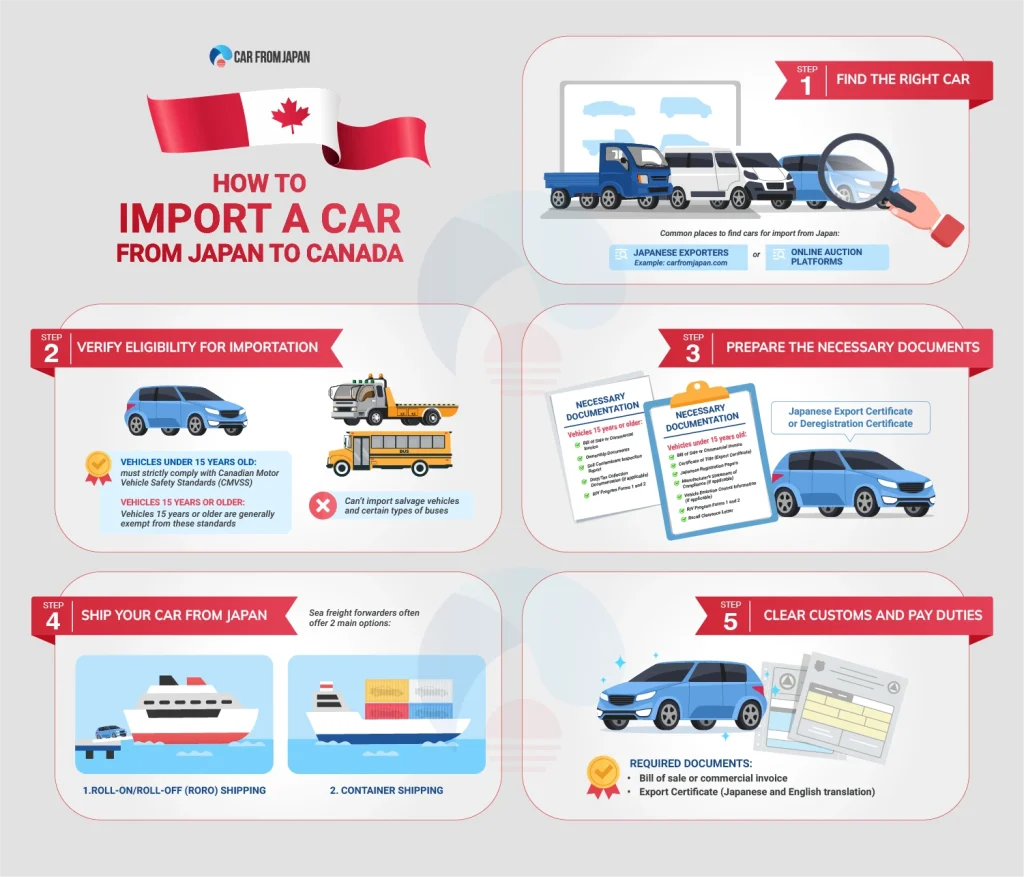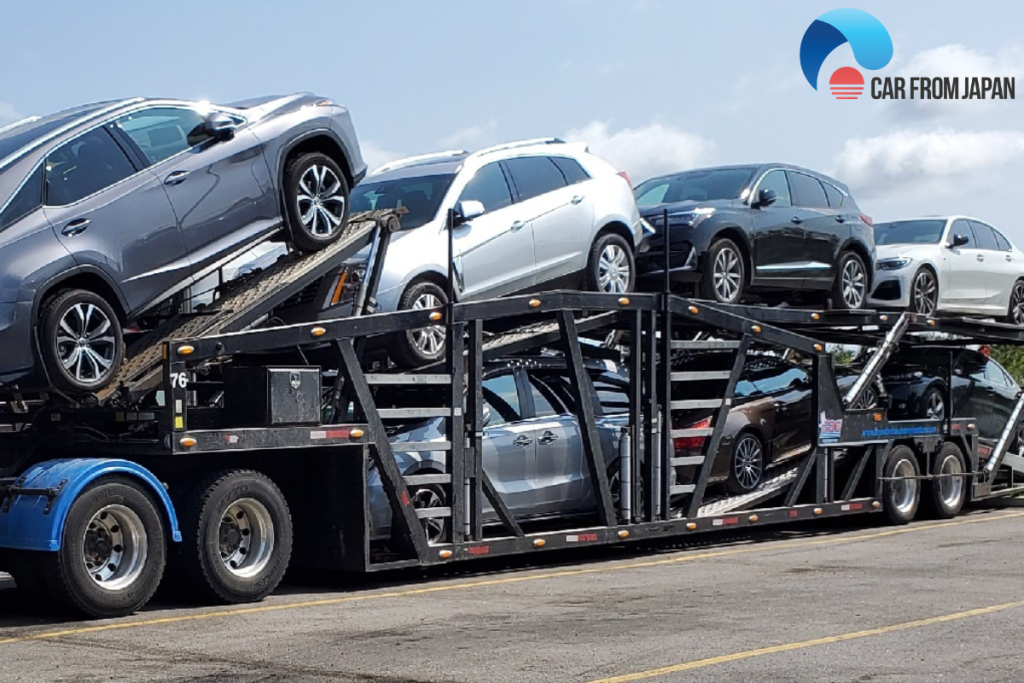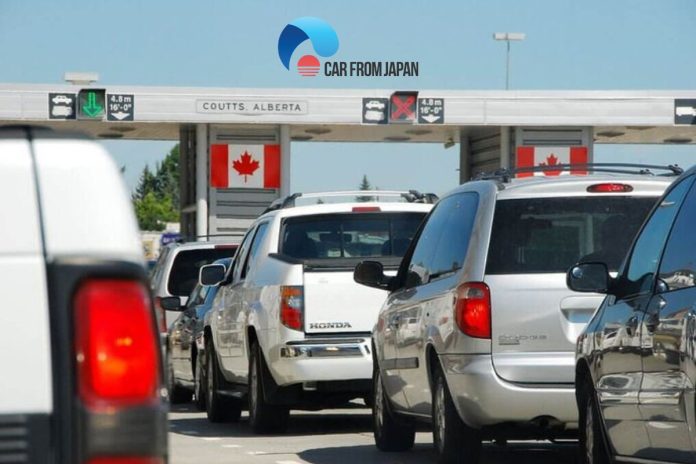Are you thinking about bringing a Japanese car to Canada? Lots of car lovers are drawn to these vehicles. They’re known for their great performance and features. If you want to know everything about how to import a car from Japan, you’re in for an interesting journey.
However, importing a car isn’t just about choosing a model and shipping it over. There are important rules and regulations in both countries that you need to follow. By knowing the steps involved, you can avoid any problems with paperwork or modifications down the line.
In this guide, we’ll help you understand how to import cars from Japan to Canada. We’ll cover everything you need to know, including cost estimates and how long the process might take.
Contents
Can I Import and Register a Car from Japan to Canada?
Yes, you can import a car from Japan to Canada, but you have to follow some important rules. Canada has strict regulations for vehicles imported from countries other than the U.S. and Mexico. All imported cars must comply with the Motor Vehicle Safety Act standards.
You can import used vehicles into Canada that are less than 15 years old, provided they meet Canadian Motor Vehicle Safety Standards (CMVSS). These standards aim to reduce the risk of death, injury, and property damage by regulating the manufacture and import of vehicles and certain vehicle equipment (like tires and child car seats).
Vehicles older than 15 years may not need to meet the same stringent safety and emissions standards as newer models. However, customs officials will still inspect certain aspects at the border.
They’ll look at the car’s age, ownership papers, and whether it’s free of soil contaminants. If everything checks out, your car is likely to receive the green light to enter the country.
You can register the car after importing it, but there are a few more steps involved. Some vehicles may need modifications to meet Canadian standards before you can get a license.
The Canadian authority may ask you to modify the car’s safety features to approve its fitness. And if your car has a “salvage” title or was in an accident, some provinces may not let you register it, even if you’ve made repairs.
Before you start the import process, it’s a good idea to check with your local licensing department. They can tell you about any extra requirements or restrictions for registering an imported vehicle in your province.

Read more: How To Import A Car From Japan To USA
Pros and Cons of Importing Cars from Japan
Bringing a car from Japan to Canada has its perks, but not without some unique challenges. We’ve listed some pros and cons that you can keep in mind when making a decision:
Pros
- Japanese cars are known for their top-notch build quality and performance.
- You’ll find older vehicles in good condition because of strict inspection requirements in Japan.
- Some Japanese cars may not be available in the Canadian market, such as rare sports cars, kei cars (small cars), etc.
- Japanese used cars often cost less than similar models in Canada, even for high-quality options.
- Japanese cars tend to hold their value well, making them a smart investment choice compared to used cars from other countries.
- The import process is not complicated if you do it yourself and even easier, if you appoint a broker company for handling shipping, paperwork, and compliance issues.
Cons
- Some provinces in Canada have rules that make it hard to register a right-hand drive vehicle.
- Cars made for Japan might not meet Canadian safety and environmental standards.
- The paperwork required for importing can be complex, involving getting approval from various agencies.
- Importing a car means paying duties, taxes, and inspection fees, which can add up.
- Many imported cars don’t come with warranties, so any repairs will likely come out of your pocket.
How to Import a Car from Japan to Canada: The Steps
You need to follow some important steps for importing cars from Japan to Canada:
Step 1: Find the right car
The first step is buying the car from a Japanese exporter.
There are many websites including Car From Japan where you will have plenty of options from classic sports cars to kei trucks at affordable prices. They will guide you through the process to import a car directly from Japan to your nearest port in Canada.
If that sounds complicated, you can also work with a Canadian dealership that specializes in Japanese imports. This option is simpler because the dealership will take care of all the legal stuff and make sure the car meets Canadian standards.
Step 2: Verify eligibility for importation
Once you’ve found a car, the next step is to check whether you can import it to Canada. Canadian rules are strict, so not all cars will be eligible.
New cars need to meet federal safety standards, while used cars must follow provincial rules. Some older cars, specifically those over 15 years old, might have an easier time getting through the process. Just remember that you can’t import salvage vehicles and certain types of buses.
Step 3: Prepare the necessary documents
Now that you have your vehicle sorted out, it’s time to gather the necessary paperwork. First, you’ll need a Japanese Export Certificate or Deregistration Certificate.
This important document comes from the Japanese government, but the importer will pick it up from the dealership that sold the car. Make sure to get this certificate after the car has been shipped.
Vehicles under 15 years old must comply with Canadian Motor Vehicle Safety Standards (CMVSS), encompassing all aspects from lighting to emissions controls. To import such a vehicle, you will require the following documentation:
- Bill of Sale or Commercial Invoice
- Certificate of Title (Export Certificate)
- Japanese Registration Papers
- Manufacturer’s Statement of Compliance (if applicable)
- Vehicle Emission Control Information (if applicable)
- RIV Program Forms 1 and 2
- Recall Clearance Letter (confirming no outstanding safety, compliance, or emissions recalls)
For vehicles 15 years or older, exemptions from stringent safety and emissions standards apply. However, it is essential to verify specific requirements with the Registrar of Imported Vehicles (RIV). The following documentation is generally required:
- Bill of Sale or Commercial Invoice
- Ownership Documents
- Soil Contaminant Inspection Report
- Duty/Tax Collection Documentation (if applicable)
- RIV Program Forms 1 and 2
Watch more:
Step 4: Ship Your Car from Japan
Now it’s time to get your car shipped to Canada. To make this happen, you’ll need to hire a logistics company.
They will help with the shipping process and make sure all the paperwork is done right. Two Canadian ports that receive vehicles from Japan frequently are Vancouver and New Westminster.
Usually, cars are shipped using a method called RoRo, which stands for Roll-on/Roll-off. Transporting the car this way may take around one to three months for it to arrive.
You might want to insure your vehicle during this time to protect it from any damage that could occur while in transit.
Step 5: Clear customs and pay duties
When your car arrives in Canada, customs will inspect it to ensure it meets local standards. You’ll need to have all the required documents ready. This includes:
- Bill of sale or commercial invoice
- Export Certificate (Japanese and English translation)
Be prepared to pay any duties, taxes, and inspection fees that may apply. Once your car clears customs, it will be ready for registration.

How Much Does It Cost to Import a Car from Japan to Canada?
The cost of importing a car from Japan to Canada can vary based on several factors, including the type of vehicle, its age, the import process, and additional fees. Let’s check out the kind of fees you may have to pay:
Purchase price of the vehicle
The biggest expense is usually the price of the car itself. This price depends on the car’s model, age, and condition. Generally, used cars in Japan are cheaper than in Canada.
However, the final price will vary based on the specific car you want. For most vehicles, you could pay anywhere from CA$ 3,000 to over CA$ 20,000, especially for luxury or rare models.
Shipping costs
The most common car shipping methods are either Roll-on/Roll-off (RoRo) or in a container. With RoRo, the car is driven onto the ship and then off to the destination. Containers can offer better protection.
On average, shipping a car from Japan to Canada costs around CA$ 3,000. The exact amount depends on where the car is coming from, like Yokohama or Osaka, and where it’s going in Canada, such as Vancouver, New Westminster, or Halifax.
The shipping cost includes several things: exporting the car from Japan, transporting it to a Canadian port, optional shipping insurance, and broker fees if you hire someone to help with the paperwork and import process.
Customs duties and taxes
When you import a vehicle to Canada, you have to pay customs duties. Usually, it’s about 6.1% of the vehicle’s value, which includes shipping costs. Keep in mind that this can change based on different factors.
You’ll also need to pay the Goods and Services Tax (GST). This tax is generally 5% of the vehicle’s value, including shipping. In some provinces like Ontario and British Columbia, there’s an extra Provincial Sales Tax (PST), and the rates can differ from one province to another.
For example, if your vehicle is worth CA$ 10,000 and the shipping costs CA$ 3,000, here’s what you might pay:
- Customs duty (6.1%): $793
- GST (5%): $650
- PST (varies by province): For instance, in Ontario, it could be 8%, which equals $1040.
Registrar of Imported Vehicles (RIV) Fees
Once your car arrives in Canada, you need to register it with the Registrar of Imported Vehicles (RIV). Doing this makes sure your vehicle meets Canadian safety standards. The registration fee is usually around CA$ 280.
After registration, your vehicle must pass an inspection to confirm it meets the necessary standards. If your car is 15 years old or older, it might be exempt from some of these requirements.
Modifications (If required)
If your vehicle doesn’t meet Canadian safety or emissions standards, you might have to make some changes. Common adjustments include modifying the lights for left-hand driving, changing the speedometer, or tweaking the emissions system.
The cost of these modifications can vary quite a bit. Depending on the vehicle, you could spend anywhere from a few hundred dollars to several thousand. On average, expect to pay between CA$ 500 and CA$ 5,000, or even more.
Inspection and registration fees
After your car clears customs and gets registered with the RIV, it must be inspected by your provincial or territorial motor vehicle authority. This inspection checks if your vehicle is safe for the road, and the fee can differ from one province to another.
Once your vehicle passes the inspection, you’ll need to pay for registration and licensing as well. These fees also vary by province.
So, if you buy a car for about CA$ 10,000, be prepared to spend an additional $5,000 to CA$ 6,000 to import it to Canada.
How Long Does It Take to Import a Car from Japan to Canada?

Importing a car from Japan to Canada can take some time, and several factors influence how long it will take. Here’s a simple breakdown to help you understand the timeline:
Shipping Time: Shipping a car from Japan usually takes between three weeks to three months. The exact time depends on the shipping method and the route taken.
Customs Clearance: Once the car reaches Canada, it needs to clear customs. This process generally takes about three to seven days.
However, it might take longer if there are any problems with the paperwork or fees. The Canada Border Services Agency (CBSA) will inspect the car to make sure it meets all import regulations.
Registrar of Imported Vehicles (RIV) Registration: If the car is less than 15 years old, you must register it with the RIV, which usually takes two to three weeks.
The time can vary based on whether the car meets Canadian safety standards or needs any modifications.
Provincial Inspection and Registration: After that, the car must pass an inspection in the province where you plan to register it.
The inspection can take one to two weeks, so be sure to schedule your appointment early. Once the car passes, you can complete the registration and get your license plates within a day or two.



